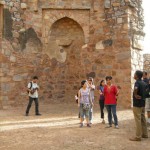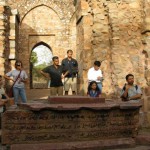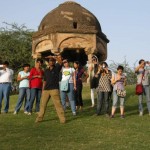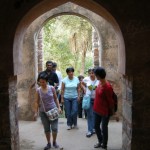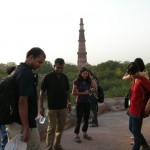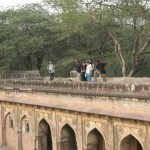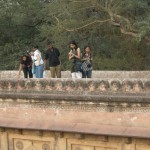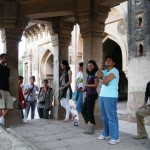Exploring monuments in Mehrauli Archaeological Park, 9 May 2010
- at balban’s tomb
- khan shaheed’s grave
- metcalfe’s folly
- boathouse
- metcalfe’s dilkhusha
- rajon ki baoli
- stepwell. rajon ki baoli
- tomb near baoli
One of the oldest inhabited neighbourhoods in Delhi region, Mehrauli is a minefield of stories. It has the earliest capital cities of Delhi and has been continuously inhabited for almost a thousand years now. This heritage walk starts at the entrance to the Mehrauli Archaeological Park. The first group of monuments one comes across is a gateway and a recently excavated area which has a courtyard and rooms built around it. Balban’s tomb stands out amongst these ruins. This 13th century royal tomb is the earliest building in India use the true arch as an element of architecture. Balban is known to be a ruthless king. To his credit, he managed to rule for up to 40 years (first as a vice regent and then as Sultan), a remarkable feat for times marked by frequent change of rulers. Balban’s grave is no longer extant but an adjacent chamber has the grave of his favorite son, Khan Shaheed. It is said that Balban died in grief at the death of this son. A little ahead is the Jamali Kamali mosque and tomb complex. Unfortunately it was closed and the caretaker was nowhere to be seen. Moving northwards from here we entered the area which was bought by Thomas Metcalfe, the British Resident at the Mughal court. He left several traces of his landscaping and ‘beautification’: there are a couple of canopies in the Park, popularly known as Metcalfe’s follies; the carriageway built over the stream diverted by Metcalfe; the 15th century dovecot converted into a boathouse by him; and the last but not the least, the Mughal tomb purchased by him & modified into a residence! This is Mohammad Quli Khan’s tomb, currently undergoing restoration work. Its rooftop provides a breathtaking view of the whole neighbourhood. One can see more of Metcalfe’s follies, one of them in form of a ziggurat, just outside the Qutb complex. This entire complex was named ‘Dilkusha’ by Metcalfe, literally, the delighter of the heart! Our next stop was the Rajon ki baoli, a step well named after masons. Right next to it is a tomb and a mosque which has some very delicate plaster decoration on the façade. The last stop on this heritage walk was a small structure which was meant to be the burial place of Khan Shaheed. Its ceiling has some exquisite decoration and one can see different styles of calligraphy employed in those times.
(posted by Rajesh Ranjan & Kanika Singh, team members, Delhi Heritage Walks)
